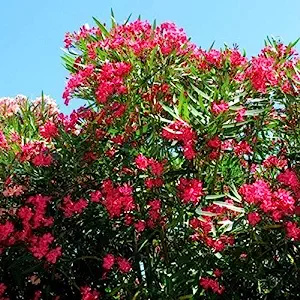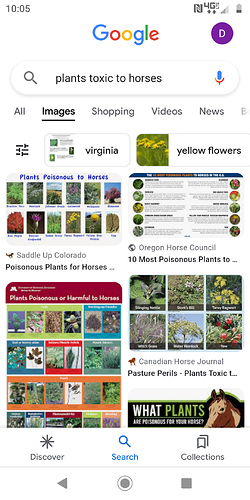Does anyone know of any good resources to help understand what plants are toxic in horse pastures?
Google can help.
Use Images so you know what they look like.
That’s how I discovered the pretty flowering plant on the berm outside my pastures was Datura/Jimson Weed/Locoweed 
Screenshot:
Usually your state or provincial agricultural department will have lists of these for your region. It’s very regional, obviously so no need panicking about things that don’t grow in your area.
Horse Owner’s Field Guide to Toxic Plants, by Sandra M. Burger, in consultation with Anthony P. Knight, BVSc, MS, MRCVS; Breakthrough Publications.
True, and also - most toxic plants don’t taste good. Horses will not eat jimsonweed, for example, unless they are absolutely starving to death.
Is there a specific plant you are concerned with?
All of them. 
I joke, it’s really just most of them.
But Google and Google Lens are your friend. Use your phone and the Google app to identify the plant in question, then you can search further if need be.
You can also use the app PlantNet to id plants from pictures & it will show you articles that include toxicity information. You can specify when you upload the pic whether it is the flowers, leaves, berries, etc & the app matches it up for you. If, like me, you don’t have good network access at home, you can just take the pic & then upload it later as well.
I used the “picture this” app to identify everything that was growing when we moved in. Then looked up its toxicity. I truly am amazed that horses have survived as long as they have as it appears like everything is trying to kill them. 
Because they don’t eat toxic plants.
Many plants are toxic so that they don’t get eaten as forage. That’s WHY they are toxic. It’s their defense mechanism to ensure species survival.
The plants that are edible tend not to need a defense mechanism - some of them are symbiotic with animals who eat them as a method of spreading seed, others spread seeds so easily that they self sow.
Things like nightshade are sown from a seed within a berry - and if the plant was eaten before fruiting it would die. So the toxicity in the plant enables it to reproduce. Horses (and other grazers) are really good at sorting out plants before eating them.
Obviously if they have nothing edible to eat they will start foraging into dangerous territory. But if there is grass and hay available, they won’t typically eat things like nightshade or buttercups.
horses will eat oleander, especially during droughts. A one mouth full bite is all that is needed to kill a horse.
Often unknowing people will plant oleander along fence lines as the plant is pretty

Horses that consume a lethal dose of oleander leaves are often found dead 8 to 10 hours later , and symptoms of poisoning rarely last more than 24 hours before death occurs. Clinical symptoms include colic, diarrhea, labored breathing, muscle tremors, ataxia, and the inability to stand
Well, I did not consider plants that don’t grow in pastures as I assumed that was what we were talking about.
But even still - if they typically won’t eat oleander except during a drought - it might fall into the same category of not enough to eat, which is a whole different story.
“While horses rarely eat green oleander leaves since they are unpalatable, there is the potential for dried leaves to accumulate in pasture areas with tall grass or end up in the horse’s daily hay ration where they may then be ingested. The toxic compounds are retained in the dried plant leaves, although in reduced quantities, where they can still cause death.”
I am fortunate to have found a university educated and trained landscape designer who specializes in horse properties. Before we even started fencing the pastures, he had all the horse toxic trees and other other vegetaion removed. Ask around and you might be lucky to have such a person in your area.
I also had a field-crop specialist from a local agricultural college come out and identify the plants in my pasture. It was very educational.
Alsike clover. Red maple. Red maple is DELICIOUS! IIRC pokeweed is also pretty palatable (and a bitch to eradicate), and then there are the things that grow on plants that can make eating delicious fescue and regular clovers bad news.
I mean if horses were smart enough to avoid everything toxic even when well fed, there wouldn’t be cases of toxicity on a pretty regular basis. There’s always something or other that comes through FB news feed or on bulletin boards - usually in the fall.
I’ve never heard that. And yes, it’s a bitch to eradicate.
The clover is an issue.
But my point is that you can drive yourself crazy picking through pastures and bales of hay for things that are technically “toxic” but you’re unlikely to actually avoid most of them being in pastures. Luckily, however, most horses don’t eat the toxic plants you’re most likely to see in pastures like jimson weed, buttercups, nightshades, cow parsnip, etc. if they have adequate forage. By all means, spray or weed if you can - but make sure they enough edible food - especially as pastures get thin - overgrazed pastures without supplemental hay are probably the ones that are most dangerous for horses.
@sascha Guess this is where Darwin and natural selection comes into play. The one horse who I knew of that ate Red Maple leaves was in a small paddock, bored enough to chew wilted leaves that came down in a storm. Dried and wilted leaves kill the red blood cells. Urine may be brown. He was dead within 2 hours, no Vet could save him. Fresh leaves are not toxic per the Tufts and MSU (Michigan State University) sites on toxic trees. Allowing horses to NOT consume of any type of maple leaves is recommended.
Owners cut all the Red Maples they had lined the driveway with. I cut all the self-seeded Maple seedlings I find here, just being preventative. Most of our trees are Oaks, hickory, safe trees.
I personally see horses avoid poke weed and milk weed as edible. They have never eaten any, though they may brush thru it to get the big purple stains on themselves. They had better stuff to consume in the field. Now that we have learned poke weed is bad, I pull it and remove plants. Almost no roots, easy to pull and stuff in a grain sack for the garbage service removal. I do not keep it on the farm for disposal.
Same with Datura that 2Dogs posted about. That is harder to pull, may need a shovel to get the root out. Spray if plants are young with herbicide. But once it flowers, I remove the entire plant to prevent that thorny seed pod from dropping any more seeds. We bought some dirt to cover drainage an it is full of those wretched Datura seeds!! So it has been work to stay ahead of flowering and seed production. They also get bagged up for the garbage service disposal.
But there are always some horses with no sense of self-preservation. They will eat anything, hurt people who ride them because they are not wary on the trail. Sadly they come to bad ends without a person hovering over them all the time. So far, we have not owned any like that. But my friends have and you feel really bad when something bad happens.
So sad  My maple experience is limited to hacking under trees and nearly all will try to reach for a bite of those delicious leaves. I’ve had to pull a branch out of a mouth but that’s as close to danger as I’ve been - small amounts of fresh leaves.
My maple experience is limited to hacking under trees and nearly all will try to reach for a bite of those delicious leaves. I’ve had to pull a branch out of a mouth but that’s as close to danger as I’ve been - small amounts of fresh leaves.
I’m jealous of your soil conditions. Pokeweed in my gardens does not come out easily!
@S1969 yes, a person could drive themself nuts trying to identify and pick every weed out of a pasture if they are unwilling (totally acceptable!) or unable to use chemicals to deal with them and I’m not suggesting that.
My point is blanket statements like horses won’t eat anything toxic unless there is nothing else to eat can be harmful because there ARE some toxic things they will eat without having to be starving.
There are also differences in toxicity.
-
Too much can cause issues like photosensitivity but not death (alsike clover)
-
Too much can cause death.
-
Very little can cause serious illness or death.
And some horses get laminitis on plain good grass pasture.
I bought my little farm almost 3 years ago now. It was first made into a horse farm in the mid-80s and the owners - horse people - lined the driveway with red maples! Right next to the paddock fence line. I don’t know what they were thinking.
Each fall I tolerate a small number to fall and still allow grazing, but then I have to go nuts and blow the leaves out of the paddocks when too many fall before I allow the horses back over there. My senior seems to love eating the leaves whereas my other mare tends to ignore them.
Just to be sure you’re not causing yourself extra work - the trees of concern have normal green leaves in the spring and summer and turn a brilliant red in the fall, right?
The ones that have dark red leaves in the summer are not red maples. If you’re not 100% sure, grab a couple of leaves and do a comparison here (there are good colour pix down the page a ways): https://www.ontario.ca/page/red-maple-leaf-poisoning-horses
or take them into a local nursery to check with someone truly knowledgeable. I just hate to think of the stress and extra work you’re getting from these trees if you don’t actually have to be so stressed!

